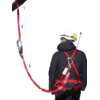Fall protection regulations say
"Each employee who has to carry out work 2 meters or more above any lower level must be protected from falling by using a security fence, a safety net or a personal fall protection system." When you work high up, you must follow directive 89/686/EEG, AFS 1996:7/2006:4 and Law on the Working Environment SFS 1977:1160.
We have divided the basic components into items 1, 2, 3, and 4
Items 1, 2, 3, and 4 make up a comprehensive personal fall protection, and if it is applied correctly it can alleviate or prevent damages from a fall. But all four items must be met, in accordance with existing legislation and applied together - only then it is comprehensive personal fall protection.
1. Anchorage connector
The anchorage connecter is regulated by EN 795 about personal fall protection and anchorage. An anchorage connector may be a beam, a security fence, a weded construction, a temporary horizontal wire etc. The standard says that the anchorage connector must be able to tolerate a static load of mininimum 12 kN in 3 minutes. The anchorage connector must be as high as possible to minimize the risk of falling, and as vertically as possible in relation to the work place as possible to avoid pendling effects and contact with lower levels in case of a fall.
2. Connecting device
The connecting device is the critical link which joins the anchorage connector to the fall protection equipment and harness. A connecting device may be a sling, steel line, or a carabiner. It must meet the requirements of EN 362 and must be able to tolerate a load of minimum 15 kN in 3 minutes.
3. Shock-absorbing device
Shock-absorbing equipment must be installed directly upon on the anchorage line or built into the sliding lock or appropriate sliding block; loose fall protection equipment is available, too. Shock-absorbing devices ensure that the body will not be stressed more than 6 kN. In order for this to work all components in the system must be produced in accordace with EN 365. Always use approved equipment in combination with shock-absorbing devices, or a fall may result in deadly damage to internal organs. Shock-absorbing devices must meet EN 355.
4. Harness
Part of the personal protection system worn by the user. But harness is considered to be a fully approved and valid personal protection. It must meet the requirements of EN 361. The selection of the harness depends on use, environment and type of work.
Please contact Certex for more information about fall protection analyses, special brochures or other fall protection training.
Basic Knowledge in Fall Protection Systems
Fall protection regulations say
"Each employee who has to carry out work 2 meters or more above any lower level must be protected from falling by using a security fence, a safety net or a personal fall protection system." When you work high up, you must follow directive 89/686/EE






